Going rockpooling is a great way to see a wide range of organisms that live on the seashore. Our guide gives you tips on the equipment you need and shows you what you might find.
Equipment you will need
- ID guide - either a pocket guide or a website
- clear bucket or tupperware - to dip into the rock pool
- clear jar - to take a closer look at specimens
- appropriate clothing for the weather, and sunscreen if required
- sturdy footwear - rocks can be slippery and sharp
Planning your trip
Choose your beach - the best beaches for pools have sheltered rocky shores. (The Wildlife Trust has a selection of good locations around the UK.)
Check tide times. The rock pools exposed at low tides have a wider variety of organisms living in them. But watch out for when the tide turns and don't get cut off. (The BBC has a tide table for the UK.)
What to do
- Approach a pool quietly and try not to cast a shadow over it. Rock pool inhabitants could think you are a predator and will hide.
- Observe carefully what you can see in the pool and on surrounding rocks. You can reach in and turn over a stone, to see what is hiding underneath.
- Take a closer look. Carefully lower your bucket into the water, then pull it back up to see what organisms you have. If you want to study one in more detail, you can transfer it with some water into the jar.
- Record and identify your finds. You can take photos and check-up online, or use a printed guide.
- Once you've finished studying your specimens, return them carefully to the pool by re-submerging your bucket. Don't leave them in the bucket for too long, as they can get stressed by temperature changes.
Life on the edge
The rock pools uncovered at low tides will have the widest variety of inhabitants. Spring tides, around the time of a full and new Moon, are the strongest and will go out the furthest. But watch out for the tide turning and don't get caught out!
Rock pools may look serene to human observers, but they can be tough environments for plants and animals to live in. Twice a day the sea washes over them and then retreats, resulting in fierce competition for resources in cramped living conditions. Inhabitants have to cope with changes in temperature, oxygen levels, moisture and salinity.
Rock pool inhabitants
Here are some common organisms that you might find in your exploration:
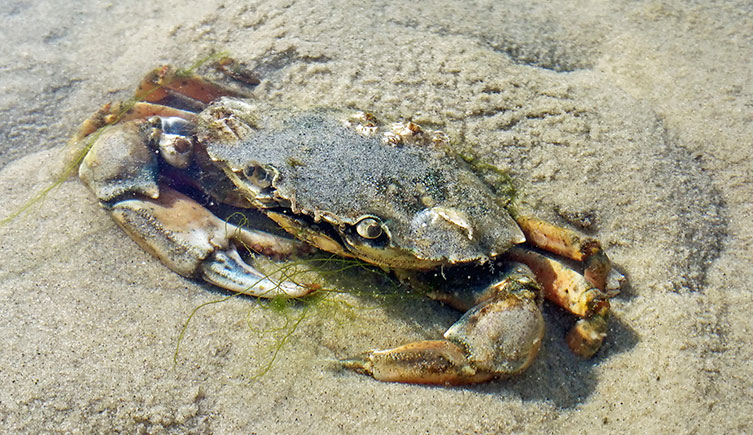
Common shore crab (Carcinus maenas)
This crab is often greenish in colour, but it can be orange or red. It has a broad shell that is up to about nine centimetres across. The shell has five spikes on either side of the eyes, and three rounded lobes between the eyes. They eat a wide variety of food, including shellfish, seaweed, and dead animals and plants.
Image © Jochen Bullerjahn via Flickr (CC BY-NC 2.0)
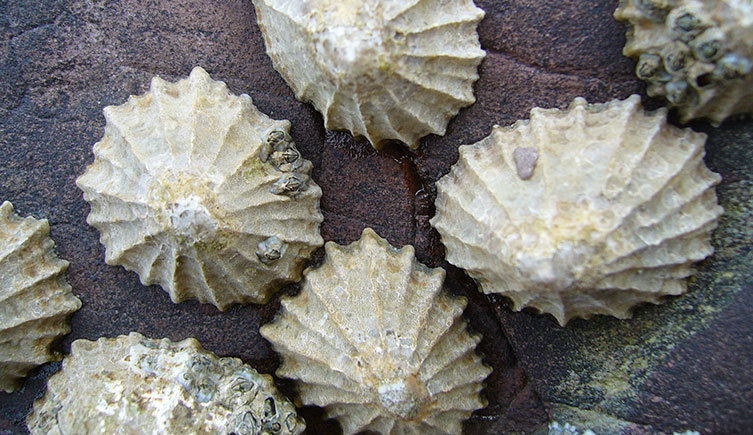
Common limpet (Patella vulgata)
This marine mollusc has a greyish conical shell with ridges running from the centre and grows to about six centimetres long. When the tide is in, limpets wander over the surface of the rock, grazing on algae. When the tide goes out, they return to their base and hunker down to retain water. They hold on so hard that over time they make an impression in the rock, called a home scar.
Image © Tango22 via Wikimedia Commons (CC BY-SA 3.0)
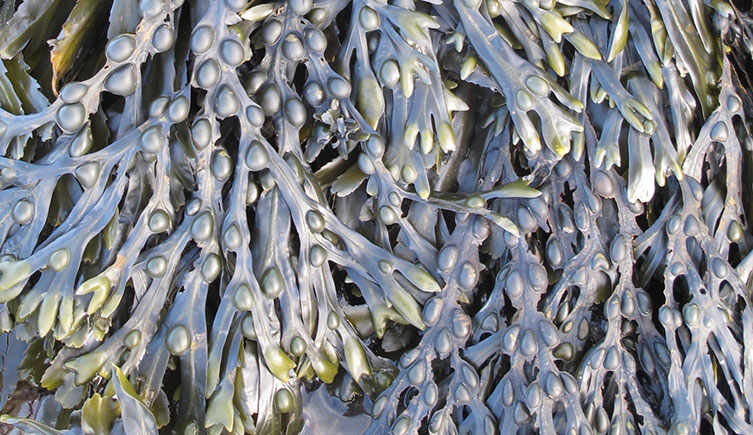
Bladderwrack (Fucus vesiculosus)
This seaweed is olive-brown with branching fronds that have a rib running down the middle of them and round air bladders. The bladders help the seaweed to float upright when the tide comes in, giving their fronds maximum exposure to sunlight and water for photosynthesis.
Why not take part in our Big Seaweed Search while you are down on the seashore?
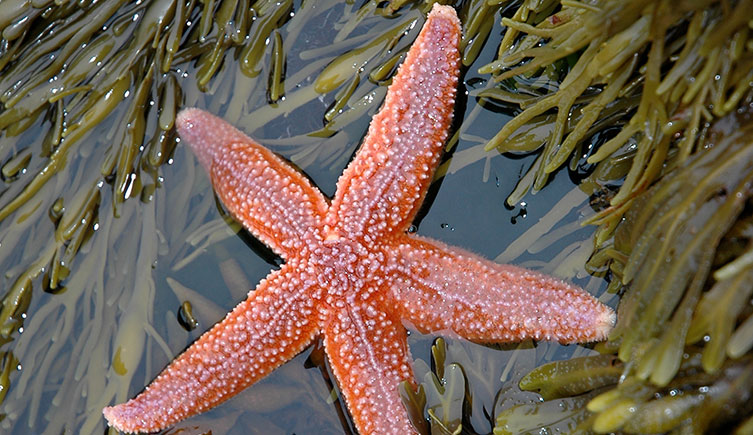
Common starfish (Asterias rubens)
This five-armed starfish is usually orange in colour but can be brown or violet. It is covered in small white spines. The animals are normally 10 to 30 centimetres in diameter but can grow larger. Starfish feed on a variety of animals including molluscs. They use their strong arms to prise open shells then invert their stomachs into the opening and digest the meal outside of their bodies.
Image © Aldaron via Wikimedia Commons (CC BY-SA 2.5)
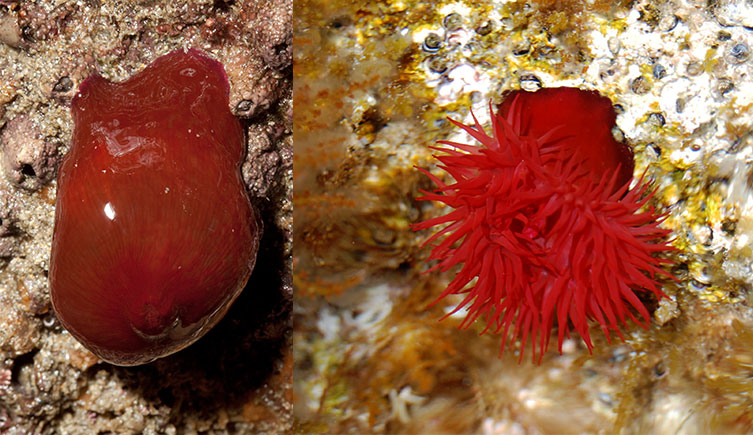
Beadlet anemone (Actinia equina)
This anemone is about five centimetres in diameter and usually red in colour, although it can be green or brown. Out of the water it looks like a blob of red jelly stuck to the rock. When in water, and undisturbed, it unfurls dozens of short tentacles. It uses the stinging tentacles to catch prey and to fight neighbouring anemones.
Left image © Andy Cowley via Wikimedia Commons (CC BY-SA 3.0)
Right image © Esculapio via Wikimedia Commons (CC BY-SA 3.0)
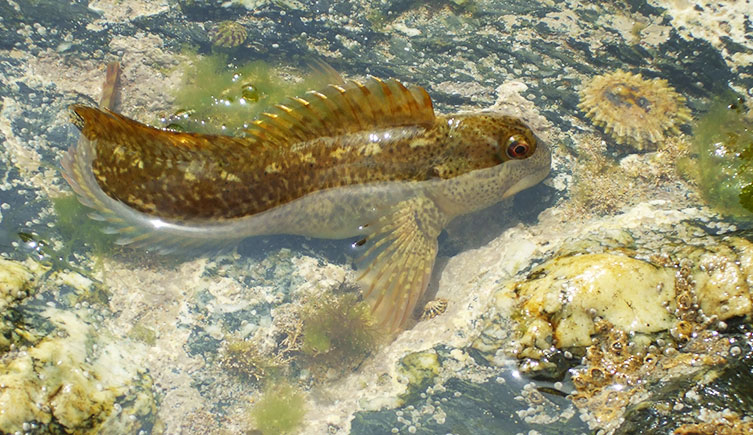
Common blenny or shanny (Lipophrys pholis)
This fish grows to about 16 centimetres in length and has an elongated body and a blunt head. It is mottled in colour - brownish with darker patches. They shelter in rock pools at low tide and then roam across the shore as the tide rises.
Image © Duncan Greenhill via Flickr (CC BY-SA 2.0)
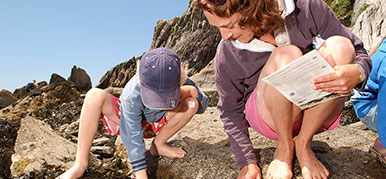
Join our Big Seaweed Search
While out on the beach, why not help out with our Big Seaweed Search?
By recording the living seaweeds you find there, you can help us monitor the effects of environmental change on Britain's sea life.

British wildlife
Find out about the plants and animals that make the UK home.
Nature Recording Hub
Discover how to record the wildlife in your urban environment.
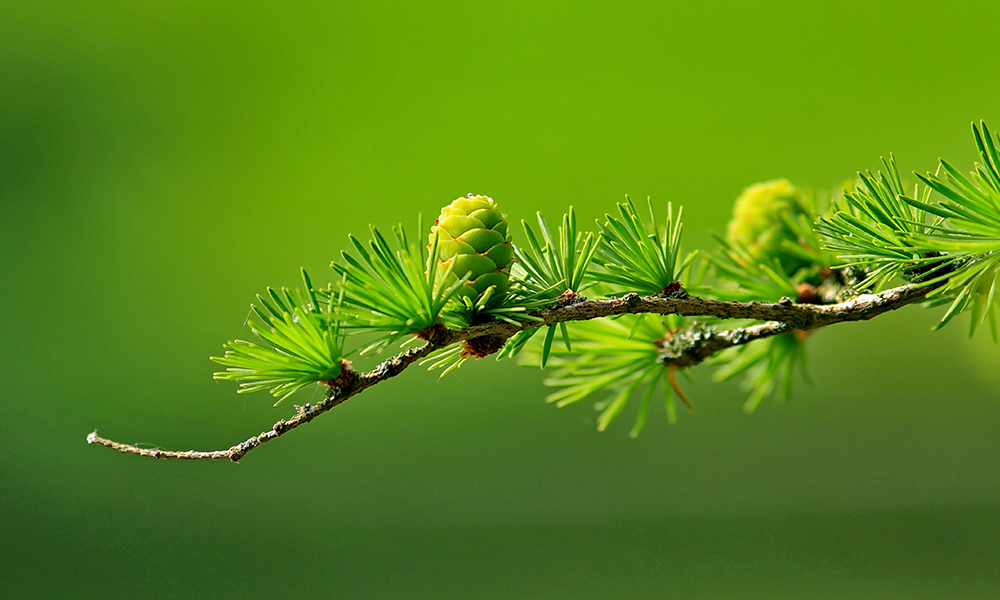
Ready to expand your knowledge?
Learn from top experts with our on-demand courses, designed for all levels of interest in the natural world.
Don't miss a thing
Receive email updates about our news, science, exhibitions, events, products, services and fundraising activities. We may occasionally include third-party content from our corporate partners and other museums. We will not share your personal details with these third parties. You must be over the age of 13. Privacy notice.
Follow us on social media